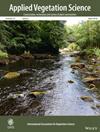Daily Fluctuating Flaiuws Affect Riparian Plant Species Distributions From Local to Regional Scales
Abstract
Aims
The number of hydropower dams has grown globally over recent decades, with significant impacts on downstream riparian plant communities. Many of these dams generate daily fluctuating flows known as hydropeaking to meet sub-daily variation in energy demands. Hydropeaking can significantly impact riparian plant communities, with obligate riparian species tending to experience the greatest negative effects on habitat suitability. Whether this pattern holds in arid biomes where daily soil moisture enhancements could benefit some plants is an open question.
Location
Colorado River, Grand Canyon, Western USA.
Methods
We used occurrence records to model species responses to variation in daily flow fluctuations across 32 689 river segments in the Western United States. We then applied estimates of hydropeaking responses derived from those models to understanding the abundance and fine scale hydrologic niches of riparian plant species in the Colorado River ecosystem downstream of Glen Canyon Dam, which has experienced vegetation expansion attributed to river regulation, including hydropeaking that began in 1964.
Results
At the regional scale, species with greater wetland dependence exhibited increasingly negative responses to hydropeaking across 1 496 species, consistent with previous studies at smaller scales. At the local scale of the Colorado River, we found that species inhabiting near-channel habitat characterized by daily inundation and exposure had positive modeled responses to hydropeaking, consistent with a long history of selection for species tolerant of hydropeaking. In contrast, species inhabiting the zone immediately above peak daily river stage had negative modeled responses to hydropeaking, suggesting that they are being excluded from otherwise suitable habitat nearer the channel.
Conclusions
These results demonstrate that hydropeaking can impact species distributions from local to regional scales by excluding obligate wetland species and reducing habitat suitability for some facultative wetland species. These results from an arid river system are consistent with those reported from other biomes.

 求助内容:
求助内容: 应助结果提醒方式:
应助结果提醒方式:


